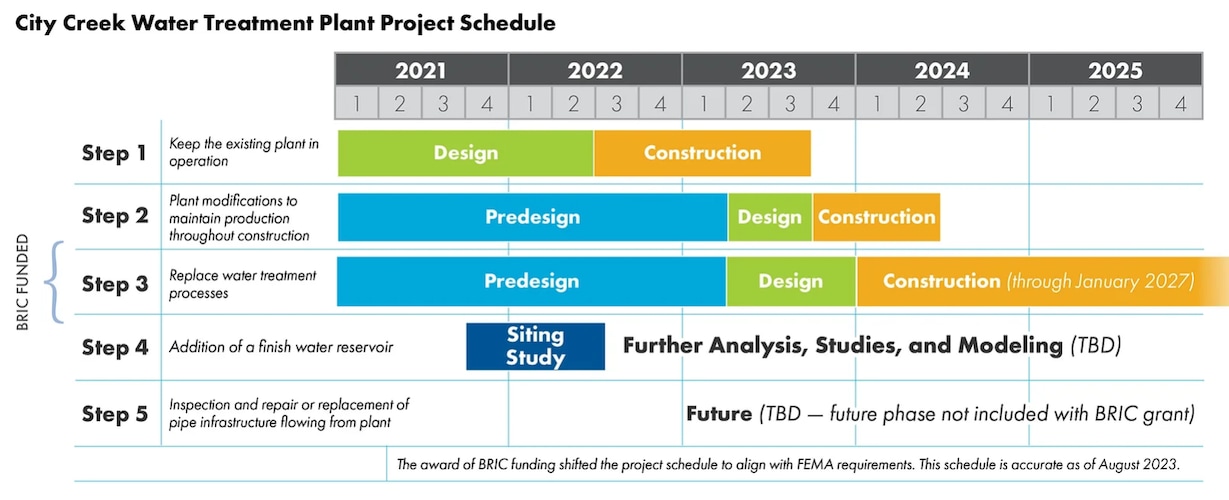Salt Lakers soon will find the much-loved City Creek Canyon off-limits on weekdays for more than 3 years.
The canyon — a popular recreation site for residents who love to bike, hike and run without encountering the traffic snarls and social media influencers that populate Big and Little Cottonwood Canyons — will close to pedestrians and cyclists on weekdays, starting Nov. 1.
That’s when Salt Lake Public Utilities is slated to begin a $90 million overhaul of the water treatment plant, nearly 3½ miles up from the canyon’s trailhead on City Creek Canyon Road. The project is scheduled to be completed in January 2027.
While hikers and cyclists likely will mourn the weekday access to City Creek, avoiding a future typhoid outbreak in the decades to come may be a fair trade-off.

A timeline of the water treatment project schedule provided by Salt Lake Public Utilities.
Why is this project happening?
City Creek is an important source of drinking water for Salt Lake City’s downtown and surrounding neighborhoods.
Salt Lake City Public Utilities provides water to roughly 365,000 people inside the city, but also in townships along the valley’s east bench. City Creek provides roughly 10-15% of the water used by that population.
City Creek was first diverted in 1847, and served as Salt Lake City’s first water source. But after decades of grazing and recreation, the watershed degraded, causing typhoid outbreaks, according to Laura Briefer, director of Salt Lake City Public Utilities.
The current water treatment plant was built in the 1950s, after the area above it was closed off to recreation from 1952 to 1965.
(Chris Samuels | The Salt Lake Tribune) The City Creek water treatment plant seen in City Creek Canyon in Salt Lake City, Friday, Oct. 20, 2023.
“Today, right now, the water quality coming from the City Creek watershed is very, very good quality,” Briefer said, “and the treatment plant is at a stage where it basically needs to be replaced.”
Besides being decades old, Briefer said, the water treatment plant was built before “seismic precautions and requirements,” Briefer said. The plant saw some damage in the earthquake that hit the Salt Lake Valley on March 18, 2020.
The public utilities department is working on rehabilitating several aging water treatment plants across the city, in stages. There are plans to replace Big Cottonwood water treatment plants, and there has already been extensive rehabilitation at the Parleys water treatment facility.
“We’re trying to strategically stagger and proactively address the water infrastructure throughout our water service area,” Briefer said.
Replacing the City Creek water treatment plant would be an important step in ensuring the wellbeing of future generations of Salt Lakers, Briefer said. “Projects like this are important to the resiliency of our community.”
(Chris Samuels | The Salt Lake Tribune) Watershed signage in City Creek Canyon in Salt Lake City, Friday, Oct. 20, 2023.
Where is the money coming from?
The Federal Emergency Management Agency gave a $37.6 million grant to Salt Lake City Public Utilities for the water treatment plant.
“That federal funding also helps us not have to raise our rates so much, or have so much debt on the city’s books,” Briefer explained.
The rest of the $90 million project will be paid for by ratepayers. In July, the city raised water rates 18%. A medium-use residential customer who paid $67.70 a month in 2022, the city estimated, would pay an additional $10.34 a month in 2023 under the new rate.
A graphic of the water treatment process provided by Salt Lake Public Utilities.
What will the project mean for recreation?
Until January 2027, people using the area for recreation won’t be able to drive personal vehicles up the canyon. Bicyclists and pedestrians will be able to access the canyon on weekends, but won’t be able to go past the water treatment plant. The area above the plant will serve as a construction staging area.
Throughout the project, Public Utilities will continue operating the water treatment plant — one reason why the construction has such a long timeline. “We have to carefully balance getting water out to the system and phasing the different parts of the process,” Briefer said. “It’s also just a really big project, with a lot of process-related work that goes into it.”
The heavy machinery and construction equipment that will be going up the road on weekdays likely will damage the pavement, Briefer said, so the city plans to resurface the road as the last step of the project.
Ensuring that Salt Lakers can still recreate in the canyon was a priority, Briefer said. The city negotiated to ensure that construction vehicles would be off the roads on the weekends.
The trail used to access the Bonneville Shoreline will remain open.
(Chris Samuels | The Salt Lake Tribune) A sign notifying people about construction to the City Creek water treatment plant in City Creek Canyon in Salt Lake City, Friday, Oct. 20, 2023.
How to stay updated
People can follow the agency on social media, or text “CCWTP” to 833-271-7589 to receive text alerts about City Creek Canyon access during construction.
You can also read more about the project at keepitpurecitycreek.com.
On Saturday, starting at 10 a.m., Public Utilities will hold an event at the guard house to kick off the project.







